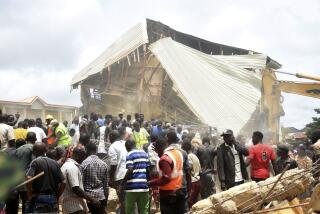At Least 90 Die in School Inferno
- Share via
KUMBAKONAM, India — Flames swept through a thatch-roofed school Friday, trapping dozens of children who clawed at brick and concrete in vain to escape after many of their teachers fled. At least 90 children were killed and 22 injured.
For the burned children, adequate medical care was a five- to six-hour drive away, and some died awaiting treatment at the hospital in this southern Indian river town. Police, blaming officials at the private school for negligence, arrested the principal.
No teachers died, and a senior fire officer said it was because they abandoned the children and ran from the burning school. But the district government administrator said it was too early to know, noting that about 700 children got out alive, probably helped by teachers.
At the local hospital, doctors applied ointment to scalded bodies. Nurses placed large banana leaves -- believed to be soothing -- on the children’s wounds.
Parents, many crying, waved bamboo and plastic fans amid the air conditioning to cool inflamed skin. Hundreds more adults waited outside.
The fire started in a kitchen and jumped across the flammable roofs of the three-story school in Kumbakonam, a temple town in a rice-farming delta about 160 miles southwest of Madras.
The Lord Krishna Middle School, with students ages 6 to 13, had just resumed classes in early July after recess during May and June, India’s hottest months.
J. Radhakrishnan, the school district administrator, said the fire erupted at 11 a.m. when the building was packed with 800 students in rooms shared by as many as six classes.
“As far as we can make out, the fire started in the kitchen of the school on the ground floor,” Radhakrishnan said. “The sparks flying up would have set fire to the thatch roof on the first floor.”
By Friday evening, 45 bodies had been cremated in mass ceremonies, he said. Several bodies were taken for cremation to nearby villages where some of the children lived. The official lowered the number of injured from 100 to 22, apparently because some had only minor injuries.
The tragedy exposed the downside of India’s “economic reforms” program, which saw a proliferation of ill-equipped private schools as the government cut spending on education to curtail its budget deficit.
Most private schools are in crowded buildings that often lack basic safety equipment such as fire alarms and sprinkler systems. They rarely have playgrounds, athletic fields or other open space.
More to Read
Sign up for Essential California
The most important California stories and recommendations in your inbox every morning.
You may occasionally receive promotional content from the Los Angeles Times.












